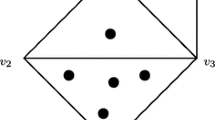Abstract
The thin plate spline method is a widely used data fitting technique as it has the ability to smooth noisy data. Here we consider a mixed finite element discretisation of the thin plate spline. By using mixed finite elements the formulation can be defined in-terms of relatively simple stencils, thus resulting in a system that is sparse and whose size only depends linearly on the number of finite element nodes. The mixed formulation is obtained by introducing the gradient of the corresponding function as an additional unknown. The novel approach taken in this paper is to work with a pair of bases for the gradient and the Lagrange multiplier forming a biorthogonal system thus ensuring that the scheme is numerically efficient, and the formulation is stable. Some numerical results are presented to demonstrate the performance of our approach. A preconditioned conjugate gradient method is an efficient solver for the arising linear system of equations.











Similar content being viewed by others
References
Ainsworth, M., Oden, J.: A Posteriori Error Estimation in Finite Element Analysis. Wiley-Interscience, New York (2000)
Altas, I., Hegland, M., Roberts, S.: Finite element thin plate splines for surface fitting. In: Computational Techniques and Applications: CTAC97, pp. 289–296 (1998)
Arnold, D., Brezzi, F.: Some new elements for the Reissner-Mindlin plate model. In: Boundary Value Problems for Partial Differerntial Equations and Applications, pp. 287–292. Masson, Paris (1993)
Boffi, D., Lovadina, C.: Analysis of new augmented lagrangian formulations for mixed finite element schemes. Numerische Mathematik 75, 405–419 (1997)
Braess, D.: Finite Elements. Theory, Fast Solver, and Applications in Solid Mechanics, 2nd edn. Cambridge University Press, Cambridge (2001)
Brenner, S., Sung, L.: Linear finite element methods for planar linear elasticity. Math. Comput. 59, 321–338 (1992)
Brezzi, F., Fortin, M.: Mixed and Hybrid Finite Element Methods. Springer, New York (1991)
Cheng, X., Han, W., Huang, H.: Some mixed finite element methods for biharmonic equation. J. Comput. Appl. Math. 126, 91–109 (2000)
Ciarlet, P.: The finite element method for elliptic problems. North Holland, Amsterdam (1978)
Ciarlet, P., Raviart, P.-A.: A mixed finite element method for the biharmonic equation. In: Boor, C.D. (ed.) Symposium on Mathematical Aspects of Finite Elements in Partial Differential Equations, pp. 125–143. Academic Press, New York (1974)
Duchon, J.: Splines minimizing rotation-invariant semi-norms in Sobolev spaces. In: Constructive Theory of Functions of Several Variables. Lecture Notes in Mathematics, vol. 571. Springer-Verlag, Berlin (1977)
Falk, R.: Approximation of the biharmonic equation by a mixed finite element method. SIAM J. Numer. Anal. 15, 556–567 (1978)
Galántai, A.: Projectors and Projection Methods. Kluwer Academic Publishers, Dordrecht (2003)
Girault, V., Raviart, P.-A.: Finite Element Methods for Navier-Stokes Equations. Springer, Berlin (1986)
Hutchinson, M.: A stochastic estimator of the trace of the influence matrix for Laplacian smoothing splines. Commun. Stat. Simul. Comput. 18, 1059–1076 (1989)
Johnson, C., Pitkäranta, J.: Some mixed finite element methods related to reduced integration. Math. Comput. 38, 375–400 (1982)
Karper, T., Mardal, K.-A., Winther, R.: Unified finite element discretizations of coupled darcy-stokes flow. Numer. Methods Partial Differ. Equ. 25, 311–326 (2008)
Kim, C., Lazarov, R., Pasciak, J., Vassilevski, P.: Multiplier spaces for the mortar finite element method in three dimensions. SIAM J. Numer. Anal. 39, 519–538 (2001)
Lamichhane, B.: Higher Order Mortar Finite Elements with Dual Lagrange Multiplier Spaces and Applications. LAP LAMBERT Academic Publishing (2011)
Lamichhane, B.: A stabilized mixed finite element method for the biharmonic equation based on biorthogonal systems. J. Comput. Appl. Math. 23, 5188–5197 (2011)
Lamichhane, B.: Two simple finite element methods for Reissner-Mindlin plates with clamped boundary condition. Appl. Numer. Math. 72, 91–98 (2013)
Lamichhane, B., Hegland, M.: A stabilised mixed finite element method for thin plate splines based on biorthogonal systems. In: McLean, W., Roberts, A.J. (eds.) Proceedings of the 16th Biennial Computational Techniques and Applications Conference, CTAC-2012, ANZIAM J. (2013)
Lamichhane, B., Roberts, S., Stals, L.: A mixed finite element discretisation of thin-plate splines. In: McLean, W., Roberts, A.J. (eds.), Proceedings of the 15th Biennial Computational Techniques and Applications Conference, CTAC-2010, vol. 52 of ANZIAM J, pp. C518–C534 (2011)
Monk, P.: A mixed finite element method for the biharmonic equation. SIAM J. Numer. Anal. 24, 737–749 (1987)
Roberts, S., Hegland, M., Altas, I.: Approximation of a thin plate spline smoother using continuous piecewise polynomial functions. SIAM J. Numer. Anal. 41, 208–234 (2003)
Scott, L., Zhang, S.: Finite element interpolation of nonsmooth functions satisfying boundary conditions. Math. Comput. 54, 483–493 (1990)
Szyld, D.: The many proofs of an identity on the norm of oblique projections. Numer. Algorithms 42, 309–323 (2006)
Wahba, G.: Spline Models for Observational Data, vol. 59 of Series in Applied Mathematic, SIAM, Philadelphia, first ed., (1990)
Wohlmuth, B.: Discretization Methods and Iterative Solvers Based on Domain Decomposition. vol. 17 of LNCS, vol. 17. Springer, Heidelberg (2001)
Acknowledgments
We are grateful to the anonymous referees for their valuable suggestions to improve the quality of the earlier version of this work.
Author information
Authors and Affiliations
Corresponding author
Rights and permissions
About this article
Cite this article
Lamichhane, B.P., Roberts, S.G. & Stals, L. A Mixed Finite Element Discretisation of Thin Plate Splines Based on Biorthogonal Systems. J Sci Comput 67, 20–42 (2016). https://doi.org/10.1007/s10915-015-0068-6
Received:
Revised:
Accepted:
Published:
Issue Date:
DOI: https://doi.org/10.1007/s10915-015-0068-6




